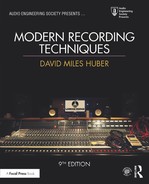Book Description
Modern Recording Techniques is the bestselling, authoritative guide to sound and music recording. Whether you’re just starting out or are looking for a step-up in the industry, Modern Recording Techniques provides an in-depth read on the art and technologies of music production. It’s a must-have reference for all audio bookshelves. Using its familiar and accessible writing style, this ninth edition has been fully updated, presenting the latest production technologies and includes an in-depth coverage of the DAW, networked audio, MIDI, signal processing and much more.
A robust companion website features video tutorials, web-links, an online glossary, flashcards, and a link to the author’s blog. Instructor resources include a test bank and an instructor’s manual.
The ninth edition includes:
- Updated tips, tricks and insights for getting the best out of your studio
- An introduction to the Apple iOS in music production
- Introductions to new technologies and important retro studio techniques
- The latest advancements in DAW systems, signal processing, mixing and mastering
